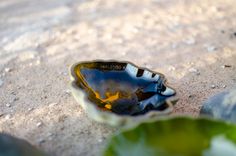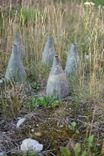About
Kollektiir

kollektiir is a practice-based design garage located in Haljala, Estonia. The studio was founded by Mari Uibo and Rait Lõhmus, a crafty collective giving waste materials another round. Mari Uibo is a hairstylist and an interior architect, currently pursuing her master’s degree at the Estonian Academy of Arts. In her MA thesis, Uibo explores the potential of human hair in furniture design, offering a second life to a material that would otherwise be thrown away. Her research is focused on slow practice, furniture design, folklore, environmental sustainability and circular design methods. Rait Lõhmus is a designer and a craftsman mostly expressing himself in glass. Lõhmus is currently researching for his MA degree on Craft Studies program at the Estonian Academy of Arts. His thesis project explores reusing and recycling possibilities of glass packages and through his research developing an author’s technique and concept - reblow. Reblow is a combination of traditional glass blowing methods and modern sustainable approach. Created objects are carrying values and hints from their previous lives.
Creations
Crambe

Sculptural Vessel, 2024 / glass, reblown champenoise / base Ø 15 cm, H 5 cm / series of 50, all unique
Crambe is a 50-piece series of unique vessels, which in their appearance resemble the wild sea kale. Each piece is a base of a reblown champagne bottle “washed ashore by the sea”.
Crambe maritima, commonly known as wild sea cabbage, is a coastal plant that has been regarded as a culinary delicacy for centuries, particularly in Europe. This matt and wavy leaved plant thrives in sandy and salty environments, often found along the shorelines of northern Europe. Every part of the plant is edible. The plant's young, tender shoots are typically blanched and cooked similarly to asparagus, either by steaming, boiling, or sautéing. The roots can be cooked as any other vegetable. The leaves are best in salads, stews and soups and small, white flowers of sea kale can be used as a garnish or added to salads for a mild, peppery flavour.
Habitaculum

Sculptural Vessel, 2024 / glass, reblown champenoise / base Ø 15 cm, H 29 cm / series of 23, all unique
Each unique serving hut is reblown from one 750 ml champagne bottle. The object has a sandblasted finish, leaving a raw top layer which stores a memory of every contact made.
The transition from hunter-gatherer societies to modern civilizations is one of the most significant developments in human history. This process, which took thousands of years, involved changes in technology, social structures, and lifestyles, leading to the complex, interconnected world we live in today. Hunter-gatherers lived in primitive huts, simple protective spaces where all the essentials were stored and safeguarded. Today our understanding of essentials has changed. We are dealing with the consequences of the industrial revolution. Raw materials are being extracted irresponsibly, which has led us to several material crises. We need to adjust our habits, values and skills to the new environment we’ve created. A world full of mass produced material banks with a potential yet to be discovered.